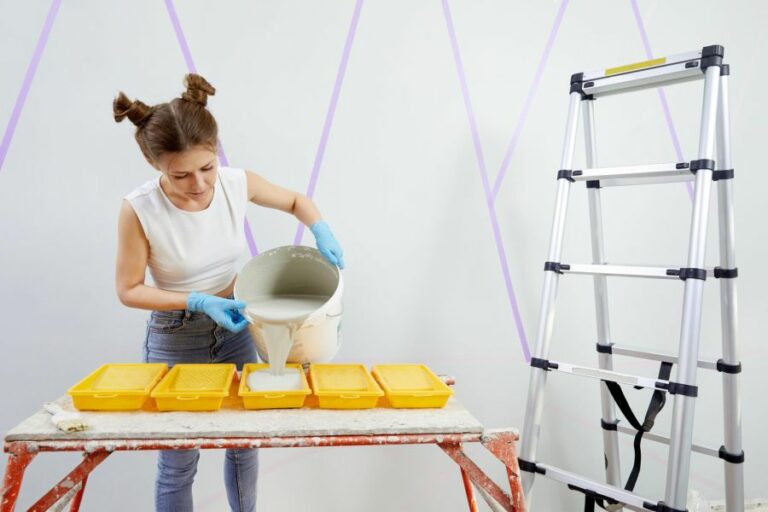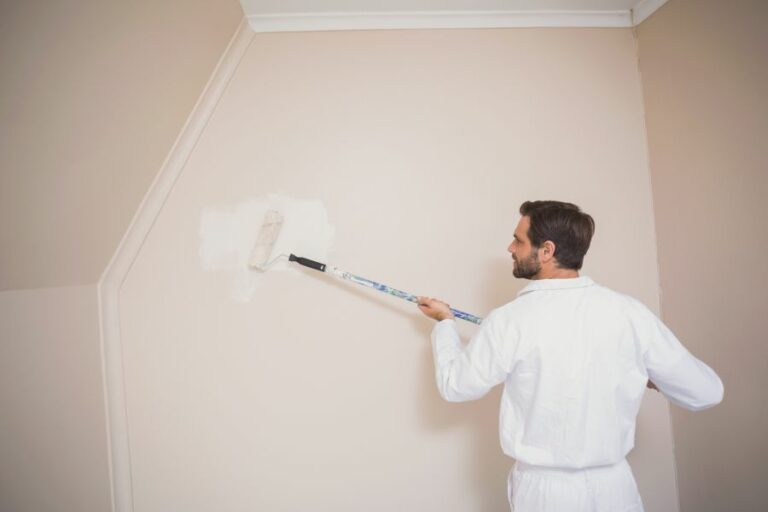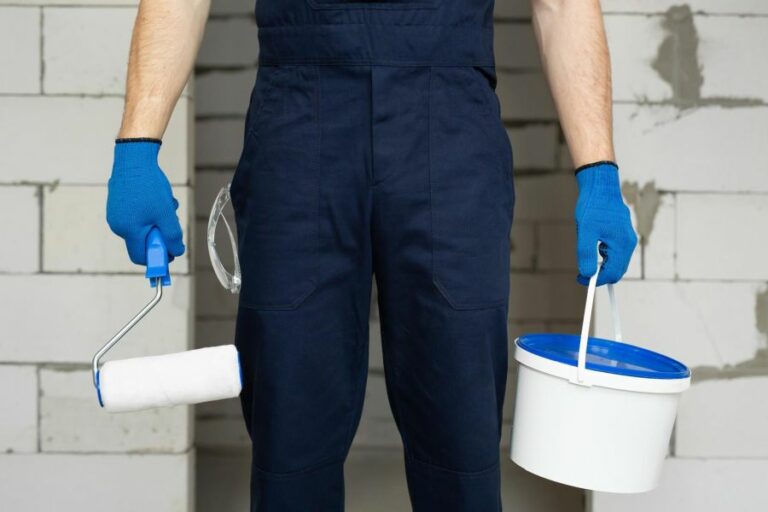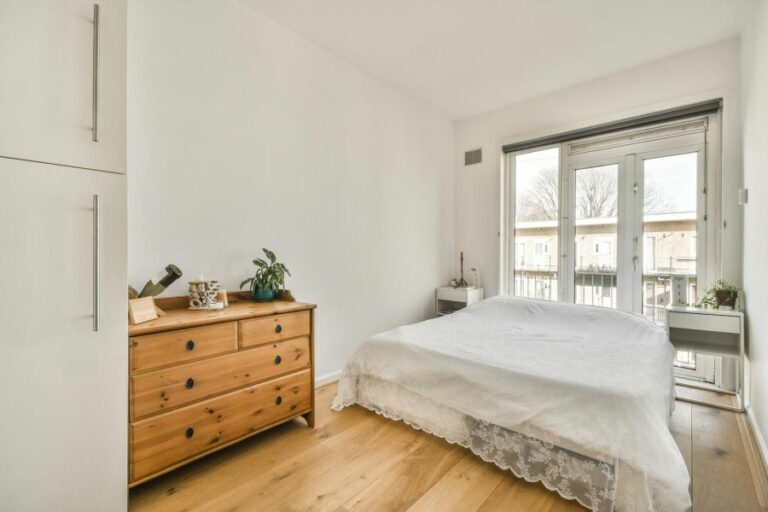High Gloss Indoor Paint Options, 25 Things You Should Know
Are you looking to revamp your interior space with a spark of elegance and style? Look no further! I have covered you with today’s best high gloss indoor paint options. With my expert guidance and recommendations, you can confidently transform your home into a dazzling haven that speaks of luxury and sophistication.
High gloss indoor paint options:>
High gloss indoor paint options include oil-based, water-based, and acrylic paints. Oil-based paints offer durability and a smooth surface, while water-based and acrylic options are eco-friendly with faster drying times. Consider factors such as surface material, humidity, sheen level, and color when choosing the right high-gloss paint for your project.

Looking to spruce up your space with a touch of luxury? Dive into our world of high gloss indoor paint options that promise durability, easy cleaning, and stunning aesthetics. Read on to transform your home like never before!
Contents
- 1 Lustrous Interior Paint Choices
- 2 Exploring the Glossiest Interior Paint
- 3 Pros and Cons of High Gloss Interior Wall Paint
- 4 Selecting the Perfect Gloss Level for Interior Paint
- 5 Identifying the Most Glossy Paint for Your Project
Lustrous Interior Paint Choices
• Introduction to High Gloss Paint
High gloss paint is a popular choice for homeowners and interior designers because of its durability and reflective properties. This type of paint has a shiny finish that can create a sleek and modern ambiance to your home. Additionally, high gloss paint is easier to clean and is resistant to stains and scuffs.
• Different Types of High Gloss Paint
– Oil-Based High Gloss Paint
Oil-based high gloss paint provides a durable and long-lasting finish, making it ideal for high-traffic areas of the home. It is resistant to stains, scuffs, and moisture, which makes it perfect for rooms such as kitchens and bathrooms.
One of the main advantages of using oil-based paint is its ability to create a hard, smooth surface that is easy to clean.
– Water-Based High Gloss Paint
Water-based high gloss paint is an eco-friendly option, as it contains fewer volatile organic compounds (VOCs) compared to oil-based paint. It also dries faster and has a lower odor, making it a more convenient choice for many homeowners.
Despite being water-based, it still provides a durable finish and is suitable for high-traffic areas of your home.
– Acrylic High Gloss Paint
Acrylic high gloss paint is another water-based option that has gained popularity for its easy application and quick drying time. It can create a glass-like finish and is suitable for both interior and exterior applications.
Acrylic paint resists yellowing and is less likely to crack over time compared to oil-based counterparts.
• Choosing the Right High Gloss Paint for Your Project
When selecting the right high gloss paint for your project, keep the following factors in mind:
- Surface Material: Consider the type of material you will be painting on. Some high gloss paints might not adhere well to certain surfaces, such as wood or metal. Consult the paint’s label or the manufacturer’s website for specific information on compatibility.
- Humidity and Ventilation: High gloss paint can take longer to dry in high-humidity environments. Make sure the room you are painting has proper ventilation to avoid prolonged drying times and uneven finished surfaces.
- Paint Sheen: High gloss paint comes in various sheen levels, from semi-gloss to full gloss. Choose the level of sheen that best suits your design preferences and the room’s function.
- Color: Take into consideration the paint color you choose, as darker colors might show more imperfections and dirt compared to lighter ones.
• Preparing the Surface for High Gloss Painting
A well-prepared surface is key to achieving a flawless high gloss finish. Follow these steps to ensure your surface is ready for painting:
- Clean the surface thoroughly to remove any dirt, debris, or grease. Use a mild detergent and warm water, then allow it to dry completely.
- Repair any holes, cracks, or imperfections in the surface using a suitable filler, and sand the area to create a smooth surface.
- Sand the entire surface to create a rough texture that will help the paint adhere better.
- Apply a coat of primer, specifically designed for high gloss paint, to ensure a smooth and even base layer. Allow the primer to dry according to the manufacturer’s instructions.
• Tips for Applying High Gloss Paint
- Invest in high-quality brushes and rollers for a smoother paint application. Look for brushes with synthetic bristles, as they are less likely to leave streaks.
- Use a paint conditioner, like Floetrol, to make the paint easier to work with and reduce brush strokes.
- Apply multiple thin coats of paint, allowing each coat to dry completely before applying the next.
- Make long, smooth strokes when painting, and avoid going back over areas that have started to dry, as this could create an uneven finish.
- Maintain a consistent direction when painting to avoid visible brush strokes.
- Allow the final coat of paint to dry completely before reassembling any fixtures or furniture. Be patient, as high gloss paint can take longer to dry compared to other finishes.
In conclusion, high gloss paint is a versatile and stylish choice for your home, offering durability, easy cleaning, and a sleek finish. By following the tips and recommendations in this article, you can transform your space confidently and expertly with the right high gloss paint.
For further information on the application techniques and product selection, visit the Paint Quality Institute website.
Exploring the Glossiest Interior Paint
• Understanding Sheen Levels
When it comes to selecting the perfect interior paint for your home, one of the essential factors is the paint sheen. The sheen level of a paint refers to its degree of glossiness, which has a significant impact on both the look and durability of the painted surface.
There are five main sheen levels to choose from:
- Flat or Matte
- Eggshell
- Satin
- Semi-Gloss
- High-Gloss
Each of these sheen levels has its unique set of characteristics that help differentiate them from one another.
• High-Gloss Paint: An Overview
High-gloss paint has the highest sheen level, which means that it reflects light more than any other type of interior paint. This paint type is known for its reflective appearance, excellent durability, and ability to resist stains and scuffs.
– Advantages of High-Gloss Paint
High-gloss paint comes with multiple benefits that make it a popular choice for specific surfaces and rooms, including:
- Durability: High-gloss paint is well-known for being easy to clean and resistant to scuffs, scratches, and stains.
- Light Reflection: The shiny finish reflects light efficiently, which makes a space appear brighter and more spacious.
- Accentuation: The reflective nature of high-gloss paint can help emphasize specific architectural features or draw attention to particular elements within a room.
– Disadvantages of High-Gloss Paint
Despite its many benefits, there are some downsides to using high-gloss paint that should also be considered:
- Imperfections: Due to its reflective quality, high-gloss paint can easily reveal surface imperfections, such as bumps or cracks.
- Application Difficulty: High-gloss paint is notoriously challenging to apply evenly, as it has a longer drying time than other finishes and is prone to showing brush or roller marks.
• Semi-Gloss Paint: A Comparison
Semi-gloss paint is the paint finish that falls right between high-gloss and satin. While it still has a shiny appearance, its sheen level is lower than that of high-gloss paint, resulting in a subtler reflection of light. To further compare these two finishes:
- Durability: Semi-gloss paint is considered durable but not to the same extent as high-gloss paint.
- Ease of Application: This paint type is slightly easier to apply compared to high-gloss paint and has a quicker drying time.
- Aesthetic: While it still offers a reflective finish, semi-gloss paint is more subdued and less likely to highlight surface imperfections.
• Choosing the Shiniest Interior Paint: Recommendations
After comparing the characteristics of both high-gloss and semi-gloss paint, the clear winner in terms of being the shiniest interior paint is undoubtedly high-gloss paint. However, it is important to bear in mind that this paint finish is not suited for every surface or room within your home.
– Ideal Surfaces for High-Gloss Paint
If you opt for high-gloss paint, consider using it on the following surfaces:
- Doors
- Window trims
- Kitchen cabinets
- Ornamental moldings
– Best Rooms for High-Gloss Paint
High-gloss paint works well in certain rooms, most notably:
- Bathrooms: The moisture-resistant capabilities of high-gloss paint make it an excellent choice for bathrooms.
- Kitchens: Due to its easy-to-clean nature and stain resistance, high-gloss paint is appropriate for kitchen spaces prone to spills and messes.
- Laundry rooms: Similarly to kitchens and bathrooms, the durability of high-gloss paint makes it ideal for resisting moisture and handling regular cleaning.
• In Conclusion
When it comes to finding the shiniest interior paint, the answer is undoubtedly high-gloss paint. However, remember to consider the room and surface where it will be applied, along with the unique benefits and drawbacks associated with this type of finish.
With these factors in mind, you can confidently choose the sheen level that best matches your interior design vision and suits your home’s needs.
Pros and Cons of High Gloss Interior Wall Paint
High gloss paint is a type of finish characterized by its reflective, mirror-like qualities. However, there are various aspects to consider when deciding if this finish is suitable for interior walls.
• Advantages of High Gloss Paint on Interior Walls
– Durability
High gloss paint is known for its durability and resistance to wear and tear. It can better withstand common household issues such as stains, scuffs, and scratches. This makes it suitable for rooms that experience frequent use or require frequent cleanings, like kitchens and bathrooms.
When it comes to maintaining high gloss walls, a simple wipe-down with a damp cloth can restore their shiny appearance.
– Light Reflection
High gloss paint is excellent at reflecting light, which can make a room appear brighter and larger. This quality is especially beneficial in spaces with limited natural light or in smaller rooms that may feel cramped.
By enhancing the amount of light bouncing around the room, high gloss walls create an airy atmosphere.
– Visual Impact
For those looking to make a statement with their interior design, high gloss walls can provide a striking visual impact. The paint’s reflective qualities can add depth and texture to a room, creating a unique aesthetic that differs from the more common matte or eggshell finishes.
• Disadvantages of High Gloss Paint on Interior Walls
– Surface Imperfections
One of the main drawbacks of high gloss paint is that it tends to accentuate any flaws, bumps, or texture on the wall surface. Therefore, careful preparation is crucial when using this paint finish, as even the smallest imperfection can become noticeable.
If your walls are not smooth, you may want to consider repairing the surface before applying high gloss paint or opting for a more forgiving finish, like eggshell or matte.
– Application Challenges
High gloss paint can be more challenging to apply and typically requires a skilled hand to ensure a smooth, even finish. Brush strokes or roller marks may become more visible with this type of paint.
A mistake during the application process can be difficult to correct, which could result in time-consuming and costly touch-ups.
– Limited Color Options
Some manufacturers offer a limited selection of colors in high gloss paint compared to other finishes. Additionally, the perception of the color may change due to the way light reflects off the surface.
For example, colors may appear darker or less saturated due to the increased light reflection. This may restrict the design options available to you when using high gloss paint.
• When to Use High Gloss Paint on Interior Walls
– Accent Walls
I recommend using high gloss paint for an accent wall if you are looking to create a striking focal point in a room. By painting one wall with a glossy finish, you can draw attention to a specific area and add depth and dimension to the space.
For example, consider using high gloss paint behind a bed in a bedroom or on a fireplace wall in the living area.
– Architectural Features
High gloss paint can be an excellent choice for highlighting architectural features, such as molding, trim, or wainscoting. The reflective finish will draw attention to these elements and make them stand out against the wall.
– Smooth and Well-Prepared Walls
As previously mentioned, high gloss paint will accentuate surface imperfections, so it is best used only on walls that have been properly prepared and are perfectly smooth.
• Conclusion
In conclusion, high gloss paint can be a beautiful and durable finish for interior walls when used thoughtfully and correctly. Its ability to reflect light, create visual impact, and withstand frequent cleaning makes it perfect for specific design situations.
However, its tendency to highlight surface imperfections, along with the potential application challenges and limited color choices, should be carefully considered before deciding if high gloss is the appropriate finish for your interior wall project.
Selecting the Perfect Gloss Level for Interior Paint
The world of interior paint can be overwhelming, with numerous options available for different surfaces, purposes, and personal preferences. One crucial aspect to consider when selecting the right paint for your indoor spaces is the paint’s gloss level.
• Gloss Levels: An Overview
The gloss level of a paint refers to its sheen or shininess once it has dried. Different gloss levels reflect varying amounts of light and can impact the overall look and feel of a space. There are four primary gloss levels to choose from:
- Flat (or Matte)
- Eggshell
- Satin
- Semi-gloss
- High-gloss
– Flat (or Matte) Finish
A flat or matte finish is the least shiny type of interior paint. It offers a non-reflective surface, making it an excellent option for hiding imperfections on walls and ceilings. However, matte finishes are not as durable as other gloss levels and can be challenging to clean, often requiring touch-ups or repainting.
This finish is recommended for low-traffic areas, such as bedrooms and living rooms, where there is minimal wear and tear on the walls.
– Eggshell Finish
Eggshell paint has a low sheen that is slightly more reflective than flat finishes. It is typically more durable and easier to clean, making it an excellent choice for areas with moderate traffic, such as hallways and dining rooms.
It’s essential to follow the manufacturer’s guidelines for application, as eggshell paints can show roller or brush marks if not applied correctly.
– Satin Finish
Satin finishes provide a subtle sheen that is more reflective than eggshell but not as shiny as semi-gloss or high-gloss finishes. This type of paint is more durable and easier to clean, making it suitable for high-traffic areas such as kitchens, bathrooms, and children’s rooms.
Satin paint is also an excellent choice for trim, doors, and windows due to its resistance to wear and tear.
– Semi-gloss Finish
Semi-gloss paints have a higher sheen level and are significantly more reflective than satin and lower-gloss options. This paint type is particularly suitable for high-humidity areas such as kitchens and bathrooms, as it is more moisture-resistant and easier to clean.
However, be aware that semi-gloss paint can highlight imperfections on walls due to its reflective properties, so proper surface preparation is crucial.
– High-gloss Finish
High-gloss paint produces the most reflective and shiny finish of all gloss levels. It is primarily utilized on surfaces such as doors, trim, and cabinets, as it provides a durable, easy-to-clean surface that resists fingerprints and stains.
However, high-gloss paint should generally be avoided on walls, as its reflective nature can exacerbate surface imperfections.
• Factors to Consider When Choosing a Gloss Level
Several factors should be considered when selecting the best gloss level for your interior paint:
– Surface Imperfections
As previously mentioned, higher-gloss paints can highlight imperfections on surfaces. Therefore, if you have walls or ceilings with noticeable flaws, it’s advisable to opt for a flat or eggshell finish to camouflage these issues.
– Durability and Cleaning
Higher-gloss finishes are generally more durable and easier to clean than their low-gloss counterparts. This factor should be considered when selecting paint for high-traffic or high-humidity areas, such as kitchens, bathrooms, and children’s rooms.
– Desired Aesthetics
The gloss level you select will significantly impact the overall look and feel of your space. Some individuals prefer a more matte finish for a cozy, welcoming atmosphere, while others may appreciate the modern elegance of a higher-gloss finish.
• In Conclusion
The best gloss for interior paint ultimately depends on your specific needs, preferences, and the space being painted. By carefully considering factors such as surface imperfections, durability, and aesthetics, you can make an informed decision that will lead to a beautiful and long-lasting result.
For additional expert advice on paint selection, consider visiting the Paint Quality Institute’s website for valuable resources and tips.
Gloss Type | Description | Best Applications |
|---|---|---|
Flat / Matte | Little to no shine. Hides surface imperfections well. | Ceilings, low traffic walls, bedrooms, living rooms. |
Eggshell | A subtle shine that is easily cleanable. Better durability than flat/matte. | Living rooms, bedrooms, hallways, and low-moisture bathrooms. |
Satin | A soft, velvety sheen that is easy to clean and durable. | Kitchens, bathrooms, hallways, family rooms. |
Semi-Gloss | A higher level of shine and durability. Easy to clean and moisture resistant. | Kitchens, bathrooms, high-moisture areas, baseboards, moldings. |
Gloss | Smooth and shiny finish. Highly durable and easy to clean. | High-use areas, furniture, cabinets, doors, moldings, trim. |
Identifying the Most Glossy Paint for Your Project
When it comes to achieving a stunning, lustrous finish on your surfaces, selecting the right type of high gloss paint is crucial.
• Introduction to Gloss and Sheen Levels
Before diving into the specific paint options, it is essential to understand the concept of gloss and sheen levels.
Gloss refers to the shine or luster that a paint exhibits upon drying, while sheen is a measure of the amount of light that reflects off the painted surface at a given angle. The higher the sheen level, the more glossy the appearance of the paint.
Gloss and sheen levels are typically categorized into five groups: flat or matte, eggshell, satin, semi-gloss, and high gloss. The difference between these categories is mainly their sheen level, with high gloss being the highest and offering the most reflective and shiny appearance.
• The Clear Winner: Oil-Based Paints
When it comes to achieving the highest gloss levels, oil-based paints have traditionally been the go-to choice.
Oil-based paint formulas usually contain a higher percentage of binder, which not only improves durability and longevity but also increases the sheen upon drying. This property gives oil-based paints its reputation as the premium option for high-gloss results.
– My Recommendation: Alkyd Enamel Paint
Alkyd enamel paints are a particular type of oil-based paint known for their outstanding gloss and durability. These paints use alkyd resins as a binder and are typically used in applications where a bold, high-gloss finish is desired, such as doors, trim, and cabinets.
An excellent example of alkyd enamel paint is Benjamin Moores Advance Interior Paint. It offers an exceptional high-gloss finish, superior leveling properties, and remarkable durability.
As a professional painter, I highly recommend this product for those looking to achieve the ultimate glossy finish on their surfaces.
• Water-Based Alternatives: High Gloss Acrylic Paints
Traditional oil-based paints may provide stunning gloss levels, but they come with some drawbacks, such as longer drying times, strong odors, and potential environmental hazards. As a result, many painters have sought water-based alternatives that can still deliver a high-gloss finish.
– My Recommendation: Waterborne Alkyd Paint
One such water-based alternative is waterborne alkyd paint, which combines the durable properties of oil-based alkyds with the convenience of water-based acrylics.
These paints have lower levels of volatile organic compounds (VOCs), which makes them a greener and more environmentally friendly choice compared to traditional oil-based products.
A popular waterborne alkyd paint is Sherwin-Williams’ ProClassic. This paint offers excellent flow, leveling and provides a glossy, silky finish. Based on my experience, it is an excellent alternative to traditional oil-based products without compromising the high-gloss look.
• The Future of High Gloss Paints: High Gloss 100% Acrylic Paints
With continuous advancements in paint technology, 100% acrylic paints are now capable of achieving high gloss levels that rival their oil-based counterparts. These paints are water-based, do not contain any oil, and produce lower VOC emissions, making them an environmentally friendly choice.
– My Recommendation: Auro 250 High Gloss Paint
One exemplary product in this category is the Auro 250 High Gloss Paint. This high-quality, eco-friendly paint is made using 100% acrylic resins and offers a fantastic high gloss finish.
As a professional, I have found that its performance and environmentally friendly properties make it an excellent option for those seeking a high gloss appearance without relying on traditional oil-based paints.
• Choosing the Right Paint for Your High Gloss Project
Ultimately, the choice of high-gloss paint will depend on your specific requirements, budget, and personal preferences.
Oil-based and alkyd enamel paints are the clear winners regarding gloss levels, but their water-based alternatives have come a long way in achieving similar results while being more environmentally friendly.
If you are considering a high-gloss project, I recommend consulting with a professional painter to ensure the proper surface preparation and products are used to achieve your desired gloss level.
Remember that the key to a successful high-gloss finish is not only the choice of paint but also the skillful application and expert craftsmanship.







